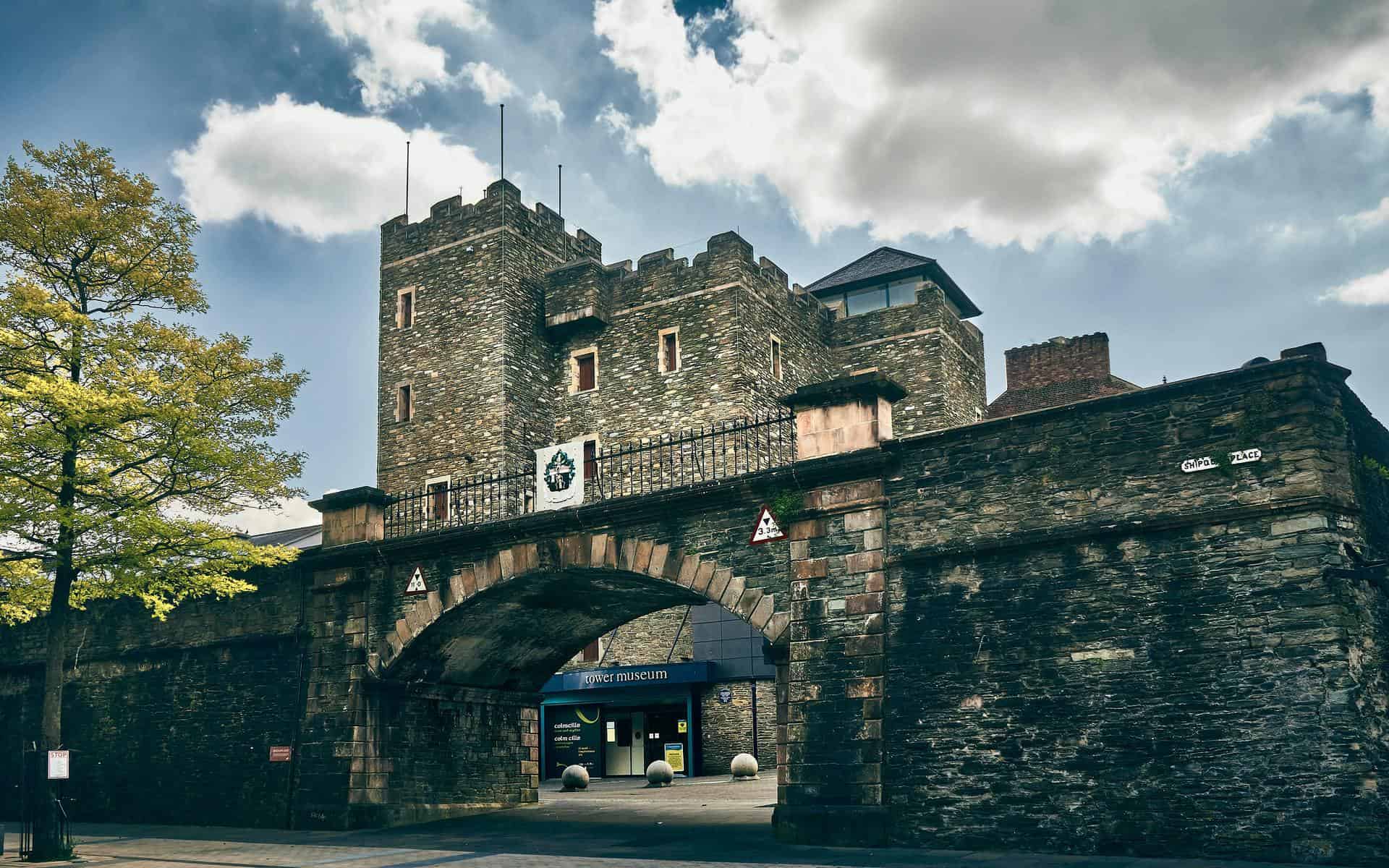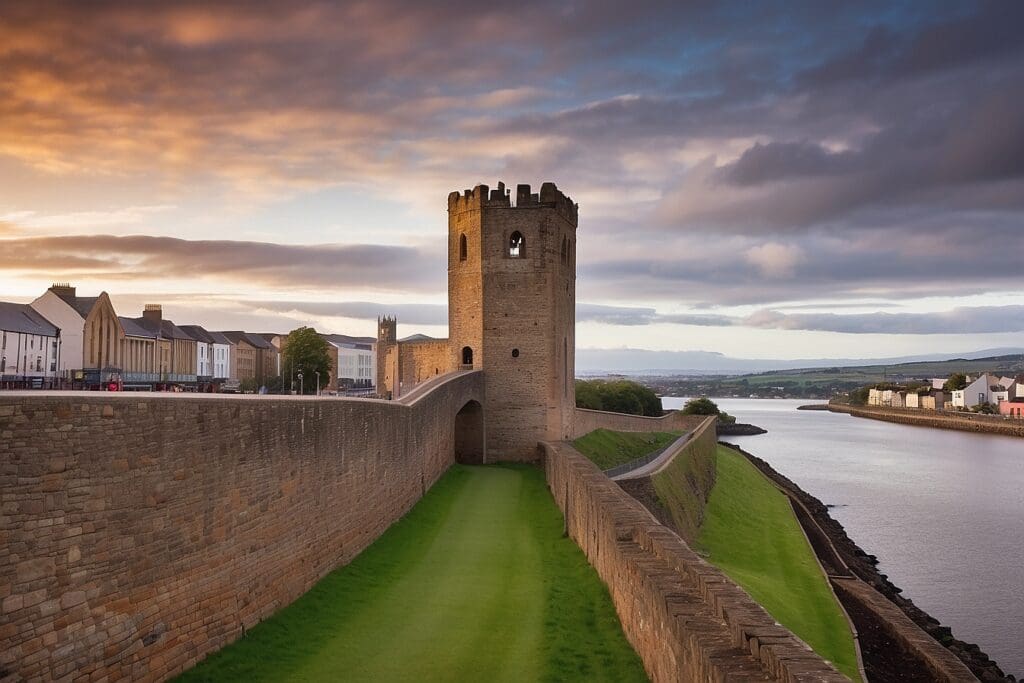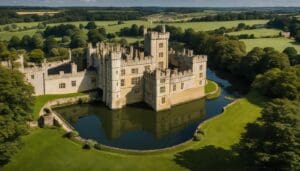Derry Walls, Northern Ireland

Updated On: April 19, 2024 by Ahmed Samir
Derry, also known as Londonderry, is a city steeped in history, with a heritage that stretches back centuries. One of its most iconic and historically significant features is the Derry Walls, a well-preserved example of a seventeenth-century fortification that encircles the city centre. These walls have played a crucial role in the city’s past and continue to stand as a symbol of resilience and endurance in the face of adversity. In this article, we will take a comprehensive look at the Derry Walls, their history, significance, and cultural importance for the people of Northern Ireland.
The Origins of Derry Walls
Derry Walls, officially known as the Walls of Derry, were constructed between 1613 and 1619 as a defensive fortification during the Plantation of Ulster, a period marked by English and Scottish colonization in Northern Ireland. The walls were designed by Sir Thomas Phillips and constructed by the Irish Society, a consortium of London-based livery companies. The primary purpose of the walls was to protect the newly established Protestant settlement within the city from potential attacks by the native Irish population.
The Derry Walls were built in a distinctive style known as a star fort. They were characterized by their pentagonal shape with four main gates, each named after a different individual or entity: Bishop’s Gate, Shipquay Gate, Butcher Gate, and Ferryquay Gate. These gates allowed access to and from the city, each with unique architectural features and historical significance.
The Siege of Derry
One of the most significant events in the history of Derry Walls was the Siege of Derry, which took place in 1688-1689 during the Williamite War in Ireland. The siege was a critical episode in the wider context of the Glorious Revolution, which saw the Catholic King James II of England and Ireland overthrown by his Protestant daughter Mary II and her husband, William of Orange.
James II, a Catholic, sought to regain his throne and enlisted the support of Catholic Ireland. This led to tensions and conflicts, with the Protestant settlers in Derry fearing persecution if James’s forces took control. On 7 December 1688, thirteen apprentice boys closed the gates of Derry to James’s army, effectively beginning the Siege of Derry.
The siege lasted for 105 days, during which the people inside the walls endured extreme hardship, including food shortages and disease. However, they held out and resisted the attempts of James’s forces to breach the walls. Relief finally came on 28 July 1689, when the English navy, under the command of Admiral George Rooke, broke the blockade and provided vital supplies to the besieged city.
The Siege of Derry is commemorated annually on 12 August with parades and events celebrating the city’s Protestant heritage and enduring spirit during those difficult times.
Architectural Features and Preservation

The Derry Walls are approximately 1.5 kilometres (0.93 miles) in circumference and are constructed primarily of earth, stone, and brick. They are remarkable not only for their historical significance but also for their impressive state of preservation. Visitors to Derry can still walk the entire circuit of the walls, taking in panoramic views of the city and the River Foyle.
The walls vary in height, with some sections rising to over 8 meters (26 feet). They are adorned with regular cannons and bastions, reminding them of the walls’ original defensive purpose. Along the walls, you can also find plaques, statues, and informational displays that provide insight into the history and significance of various locations.
Restoration and maintenance efforts over the years have ensured that the Derry Walls remain in excellent condition. The Derry City Walls Conservation Plan, developed in 2010, outlines a comprehensive strategy for continued protection and enhancement. This plan includes measures for ongoing maintenance, interpretation, and accessibility, allowing locals and tourists to explore this historical treasure.
Cultural Significance
The Derry Walls hold immense cultural and historical significance for the people of Derry and Northern Ireland. They symbolize the city’s identity and resilience, particularly in adversity and conflict. The walls are a testament to the enduring spirit of the residents who withstood the Siege of Derry and defended their way of life.
Beyond their historical importance, the Derry Walls have also become a symbol of reconciliation and unity. In a region marked by religious and political divisions, the walls serve as a physical and symbolic bridge between communities. They remind people of the shared history that binds them together, regardless of their background or beliefs.
The Derry Walls are also a popular tourist attraction, drawing visitors from all over the world who explore their rich history and stunning views. Tourism is vital to the local economy, with visitors contributing to the city’s cultural vibrancy and economic well-being.
Exploring the Derry Walls
Visiting the Derry Walls provides a unique opportunity to step back in time and immerse yourself in history. Here are some of the key sites and experiences you can enjoy when exploring the walls:
- Bishop’s Gate: Start your journey at Bishop’s Gate, one of the four main gates of the walls. This gate is a beautifully preserved example of Renaissance architecture and features impressive sculptures and intricate stonework.
- Shipquay Gate: As you continue along the walls, you’ll come to Shipquay Gate. This gate is known for its maritime history, as it was the main entrance to the city’s bustling port during the 18th century.
- Butcher Gate: Butcher Gate is another of the four main gates and gets its name from the livestock market that used to be held nearby. Today, it is a picturesque spot with a charming clock tower.
- The City Gates: Besides the main gates, there are three smaller gates along the walls: Magazine Gate, Castle Gate, and New Gate. Each has its unique character and historical significance.
- The Bogside Murals: A short walk from the walls will take you to the Bogside area, where you can explore the famous Bogside Murals. These large-scale artworks depict the Troubles and other significant events in the city’s history.
- The Apprentice Boys Memorial Hall: Located near Bishop’s Gate, this hall is dedicated to the memory of the apprentice boys who closed the city gates during the Siege of Derry. It houses a museum that provides further insight into this pivotal event.
- St. Columb’s Cathedral: This stunning cathedral, located within the city walls, is the city’s oldest building and a beautiful example of Gothic architecture. It is worth a visit to explore its history and architecture.
- Panoramic Views: Remember to take in the breathtaking views of the city and the River Foyle as you walk along the walls. The vantage points offer excellent photo opportunities and a chance to appreciate the city’s layout and natural surroundings.
- Guided Tours: For a more in-depth understanding of the history and significance of the Derry Walls, consider joining a guided tour. Knowledgeable guides can provide insights and stories that bring the walls to life.
Beyond the Walls: Discovering Derry’s Diverse Attractions
Derry, also known as Londonderry, is a city in Northern Ireland with a rich history and a wide range of attractions to discover beyond its famous walls. Here are more attractions to explore in Derry:
- The Guildhall: This historic building is an iconic symbol of Derry. It boasts stunning architecture and is home to the impressive stained glass windows of the Main Hall. Visitors can explore the Guildhall‘s history and attend various events and exhibitions.
- Museum of Free Derry: Located in the Bogside area, this museum offers a detailed and moving account of the events leading up to and during the Troubles in Northern Ireland. It’s a sobering yet essential visit to gain insight into the city’s recent history.
- St. Columb’s Park: This large urban park offers a peaceful escape from the hustle and bustle of the city. It features scenic walking trails, a playground, and a beautiful walled garden. It’s an ideal place for a stroll or a family picnic.
- The Peace Bridge: This iconic pedestrian bridge spans the River Foyle and connects the city centre with Ebrington Square. It’s an architectural marvel and a symbol of peace and reconciliation in a once-divided city.
- Ebrington Square: Located on the other side of the Peace Bridge, Ebrington Square is a cultural and events space. It hosts various concerts, festivals, and exhibitions throughout the year. The square’s open layout offers fantastic views of the city.
- Foyle Valley Railway Museum: Railway enthusiasts will enjoy this museum, showcasing the region’s history of railways. It features a collection of vintage locomotives, carriages, and railway memorabilia.
- The Tower Museum is located within the city walls and provides a fascinating journey through Derry’s diverse history. It houses two main exhibitions: “The Story of Derry” and “An Armada Shipwreck – La Trinidad Valencera.”
- The Amelia Earhart Centre and Wildlife Sanctuary: Learn about the famous aviator Amelia Earhart and her historic transatlantic flight from Derry. The nearby wildlife sanctuary offers opportunities for bird watching and peaceful walks.
- The Craft Village: Nestled within the city walls, the Craft Village is a charming area filled with traditional shops and boutiques. Visitors can shop for locally made crafts, jewellery, and artisanal goods.
- Shipquay Street: This bustling street has shops, cafes, and restaurants. It’s a great place to explore the local cuisine, grab a coffee, or indulge in retail therapy.
- Foyleside Shopping Centre: For those looking for a more modern shopping experience, Foyleside is the largest shopping centre in Derry. It boasts many shops, from high-street brands to speciality stores.
- St. Eugene’s Cathedral: This magnificent Roman Catholic cathedral is an architectural gem with beautiful stained glass windows and intricate artwork. It’s a place of worship and historical and cultural significance.
- The Playhouse Theatre: If you’re interested in the arts, The Playhouse Theatre offers a diverse program of live performances, including plays, musicals, and concerts.
- Derry City F.C.: For sports enthusiasts, catching a football (soccer) match at the Brandywell Stadium can be an exciting experience. Derry City F.C. is a well-known club with a passionate local following.
- Day Trips: Derry’s location in Northern Ireland is a great starting point for day trips to nearby attractions, such as the Giant’s Causeway, Mussenden Temple, and Donegal in the Republic of Ireland.
Derry is a city that blends its rich history with a vibrant contemporary culture. Whether you’re interested in history, arts, nature, or simply enjoying the atmosphere of a lively city, Derry has something to offer every traveller.
Last Words
The Derry Walls of Northern Ireland stand as a testament to centuries of history, endurance, and the unyielding spirit of the people of Derry. From their origins as a defensive fortification to their role in the Siege of Derry and their continued cultural significance, these walls have played a central role in shaping the city’s identity.
Today, the Derry Walls are a cherished heritage site, a symbol of unity, and a draw for tourists eager to explore their rich history and stunning architecture. Whether you’re interested in history architecture or simply enjoy breathtaking views, visiting Derry and its iconic walls is a journey through time that you will remember. As you walk in the footsteps of those who defended the city in the past, you’ll gain a deeper appreciation for the enduring legacy of the Derry Walls.






